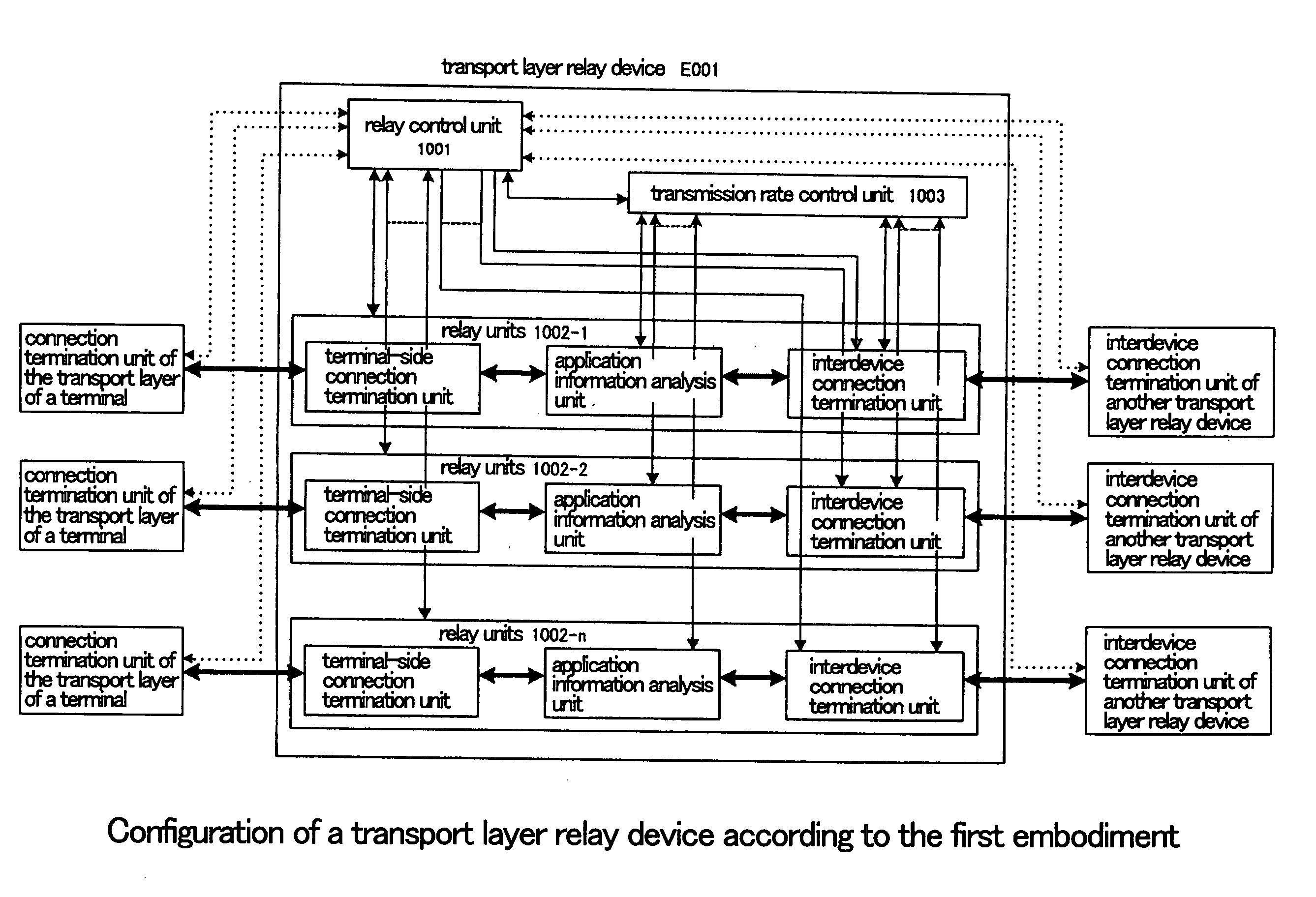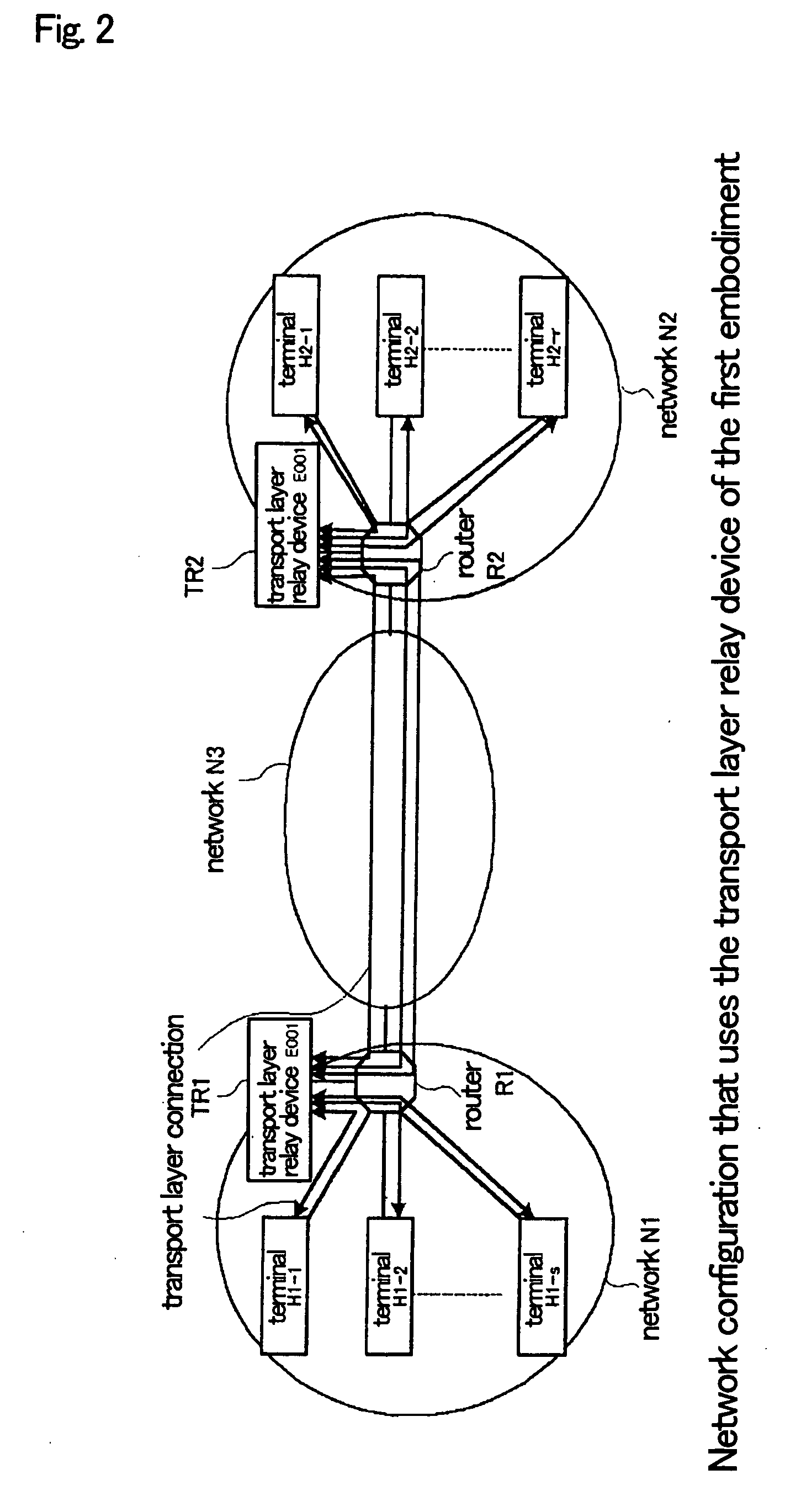Transport layer relay method, transport layer relay device, and program
a relay device and transport layer technology, applied in the field of communication systems, can solve the problems of poor communication efficiency, inability to realize efficient communication, and cost of a multiplicity of devices, and achieve the effect of redistributing bandwidth, low cost, and redistributing bandwidth
- Summary
- Abstract
- Description
- Claims
- Application Information
AI Technical Summary
Benefits of technology
Problems solved by technology
Method used
Image
Examples
first embodiment
of the Present Invention
Explanation of the Configuration of the First Embodiment of the Present Invention
[0064] Explanation next regards the details of the configuration of the first embodiment of the present invention with reference to the figures.
[0065]FIG. 1 is a block diagram of the interior of transport layer relay device E001 of the first embodiment of the present invention. Transport layer relay device E001 includes internally: relay control unit 1001, relay units 1002-1-1002-n, and transmission rate control unit 1003. Transport layer relay device E001 can be realized by a computer. When realized by a computer, a program for realizing relay control unit 1001, relay units 1002-1-1002-n, and transmission rate control unit 1003 is recorded on a disk, a semiconductor memory, or other recording medium. This program is read by a computer, and through the control of the operations of the computer, relay control unit 1001, relay units 1002-1-1002-n, and transmission rate control un...
second embodiment
of the Present Invention
[0135] Explanation of the Configuration
[0136] Explanation next regards the details of the configuration of the second embodiment of the present invention with reference to the accompanying figures.
[0137]FIG. 5 is a block diagram showing the interior of transport layer relay device E002 of the second embodiment of the present invention. This transport layer relay device E002 differs from transport layer relay device E001 of the first embodiment of the present invention only in the addition of network condition estimation unit 2004 and the connection to transmission rate control unit 2003. The operations of relay control unit 1001, relay units 1002-1-1002-n, the terminal-side connection termination units that are inside the relay units, the application information analysis units, and interdevice connection termination units are the same as the operations of the equivalent components of transport layer relay device E001 of the first embodiment, and redundant e...
third embodiment
of the Present Invention
Explanation of the Configuration of the Third Embodiment of the Present Invention
[0182] The following explanation regards the details of the configuration of the third embodiment of the present invention with reference to the accompanying figures.
[0183]FIG. 8 is a block diagram of the interior of transport layer relay device E003 of the third embodiment of the present invention. Transport layer relay device E003 includes: relay control unit 3001, relay units 3002-1-3002-n, transmission rate control unit 3003, interdevice connection termination unit 3004, and MUX-DEMUX unit 3005. Transport layer relay device E003 can be realized by a computer. When transport layer relay device E003 is realized by a computer, a program for realizing relay control unit 3001, relay units 3002-1-3002-n, transmission rate control unit 3003, interdevice connection termination unit 3004, and MUX-DEMUX unit 3005 is recorded on a disk, semiconductor memory, or other recording medium....
PUM
 Login to View More
Login to View More Abstract
Description
Claims
Application Information
 Login to View More
Login to View More - R&D
- Intellectual Property
- Life Sciences
- Materials
- Tech Scout
- Unparalleled Data Quality
- Higher Quality Content
- 60% Fewer Hallucinations
Browse by: Latest US Patents, China's latest patents, Technical Efficacy Thesaurus, Application Domain, Technology Topic, Popular Technical Reports.
© 2025 PatSnap. All rights reserved.Legal|Privacy policy|Modern Slavery Act Transparency Statement|Sitemap|About US| Contact US: help@patsnap.com



